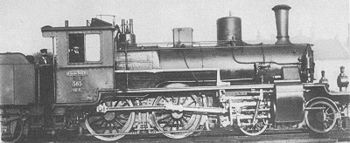Saxon VIII V2
| VIII V 2 DR series 36.9-10 |
||||
|---|---|---|---|---|
| Manufacturer: |
Sächsische Maschinenfabrik ( Chemnitz ) Schwartzkopff ( Berlin ) Maschinenfabrik Esslingen Linke-Hofmann ( Breslau ) |
|||
| Numbers: | 519-538 36 901-919 |
539-568 36 921-948 |
569-636 36 951-1014 |
|
| Years of construction: | 1896/97 | 1897-1899 | 1900-1902 | |
| Retirement: | until 1931 | |||
| Number: | 20th | 30th | 68 | |
| Axis formula: | 2'B n2v | |||
| Gauge: | 1,435 mm | |||
| Length over buffers: | 16,790 mm | |||
| Empty mass: | 44.7 t | 45.5 t | 49.0 | |
| Friction mass: | 29.1 | 30.2 | 32.0 | |
| Service mass: | 49.5 t | 51.6 t | 54.5 t | |
| Axle travel mass: | 14.5 t | 15.1 t | 16.0 | |
| Top speed: | 80 km / h | |||
| indicated performance: | k. A. | |||
| Driving wheel diameter: | 1,590 mm | |||
| Impeller diameter: | 1,065 mm | |||
| Control type: | Heusinger | |||
| HD cylinder diameter : | 440 mm | 460 mm | 460 mm | |
| LP cylinder diameter : | 650 mm | 680 mm | 680 mm | |
| Piston stroke: | 600 mm | |||
| Boiler overpressure: | 12 bar | 12 bar | 13 bar | |
| Number of heating pipes: | 216 | 216 | 254 | |
| Heating pipe length: | 3,800 mm | |||
| Grate area: | 1.87 m² | |||
| Radiant heating surface: | 13.4 m² | 13.4 m² | 15.6 m² | |
| Tubular heating surface: | 103.1 m² | 103.1 m² | 121.3 m² | |
| Evaporation heating surface: | 112.1 m² | 112.1 m² | 130.77 m² | |
| Tender design: | sä 3 T 9 | sä 2'2 'T 16 | sä 2'2 'T 21 | |
| Brakes: | Westinghouse air brake | |||
As Genus VIII 2 designated Royal Saxon State Railways four-coupled Schlepptender locomotives for passenger service . The Deutsche Reichsbahn classified the locomotives in the 36.9-10 series from 1925 .
history
In terms of design, the locomotives were derived from the express train locomotives class VIII V 1 . As passenger locomotives, however , the VIII V 2 received significantly reduced coupling wheel sets. To distinguish them from the express train locomotives, the new machines were given a subscript "2" in the generic name.
Between 1896 and 1902, 118 locomotives were put into service by the Royal Saxon State Railways. In addition to the in-house supplier Sächsische Maschinenfabrik in Chemnitz , Schwartzkopff in Berlin, the Maschinenfabrik Esslingen and Linke-Hofmann in Breslau were involved in the production of the locomotives .
No. 528 from the first production series was lost during the First World War. The machine was later operated by the Polish State Railways PKP as Od101-1.
The remaining locomotives came from 1920 to the newly founded Deutsche Reichsbahn , which decommissioned a few copies in the early 1920s. In 1925, 111 locomotives were given the new road numbers 36 901–919, 36 921–948 and 36 951–1014. With the increased appearance of modern superheated steam locomotives such as the Saxon XII H2 , the XIV HT and the use of Prussian designs in Saxony, they soon migrated to subordinate services. By 1931 , the locomotives were decommissioned and scrapped. No copy has been preserved in a museum for posterity.
commitment
The locomotives were used in preference to passenger trains on the railway lines leading into the Ore Mountains. However, operations in front of express trains are also documented. Thanks to the small drive wheels, the locomotives had good acceleration, especially since the possible speed of 80 km / h in front of express trains in the mountains was sufficient. The locomotives were used primarily on the routes from Chemnitz to Riesa , Annaberg and Aue , from Dresden to Görlitz and Zittau and on the Dresden– Leipzig route .
In the early 1920s, they were also responsible for transporting excursion trains with up to 50 axles from Dresden to Saxon Switzerland. Most recently, the locomotives were still used in Dresden suburban traffic, and use in front of Leig trains is also known.
technical features
The boiler had a Belpaire fire box typical of the Saxon locomotives and was drawn in between the frame cheeks in the fire box area. Two steam jet pumps of the type Schäfer & Buddenberg were used to feed the boiler .
The steam engine was a two-cylinder compound drive with Heusinger control and Lindnerscher start-up device. The first coupled axle was driven. The front two-axle bogie had an axle base of 2,150 mm and lateral mobility of 39 mm.
A Westinghouse air brake was installed as the brake. The brake acted on both coupling wheel sets on both sides. The wheel sets in the bogie were unbraked.
The locomotives were coupled to sä 3 T 9, sä 2'2 'T 16 and 2'2' T 21 tenders from Saxony.
literature
- Fritz Näbrich, Günter Meyer, Reiner Preuß: Lokomotivarchiv Sachsen 1 . transpress VEB Verlag for Transport, Berlin 1983, or Alba Publication Alf Teloeken GmbH + Co KG, Düsseldorf, ISBN 3-87094-096-4
- Erich Preuß , Reiner Preuß : Saxon State Railways , transpress Verlagsgesellschaft mbH, Berlin 1991, ISBN 3-344-70700-0 .

